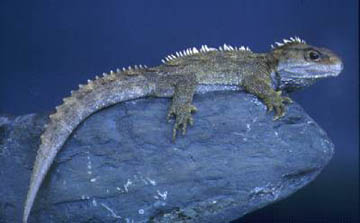

PIECE PROFILES
EN2027 & EN2215 - Tuatara - Winter Witch
(Reptile Pictures & Information)
The name Tuatara comes from a type of reptile, as Tuatara herself can change into a lizard in the books
All the information below along with the photos are from The Mount Bruce National Wildlife Centre web site with the exception of the bottom photo which came from the NZPhoto web site, Please feel free to visit these sites
---------------------------------------------------------------------------------
 The Mt
Bruce National Wildlife Centre has been involved with tuatara since 1974. The Mt
Bruce National Wildlife Centre has been involved with tuatara since 1974.
Tuatara are protected by law and a recovery programme is in place to maintain and increase their population. What are tuatara? Tuatara means "spiny back" in Maori. Tuataras are
reptiles but they are very different to lizards, crocodiles and amphibians
(frogs, salamanders). Tuatara have a primitive body structure that supports the
theory that they are one of the oldest and most un-evolved species, having
hardly changed in the past 220 million years. |
|
|
|